Post by Rachel O’Brien Director of
the RSA prison reform
Programme, who sets out the RSA’s proposal to the MoJ to support prison reform
on the ground.. While everyone working and living in prisons is, naturally,
mainly , Ms O’Brien
argues strongly in an accompanying RSA blog that reform is
not a distraction from improving prison safety, but integral to it.
RSA’s New Futures
Network Proposal Submitted to Ministry of Justice
Prisons exist to
keep society safer. But to fight crime as effectively as possible, prisons must
do more than just incapacitate criminals for the length of their sentence; they
must ensure that when they leave jail they do not offend again.
Working closely
with practitioners and the Ministry of Justice (MoJ), the RSA has been working
on developing the New Futures Network (NFN), a proposed new body that aims to
work with prison leaders to support reform and ensure that when prisoners
return to their communities, they have the right skills to get a job, access to
employers and are able to build a better life. Ultimately achieving this goal
will require prisons and the criminal justice system to overcome long-term
challenges, including coping with a lack of prison capacity, the prevalence of
drugs, and a rise in the number of assaults, suicides and incidents of
self-harm.
Between January and
May this year, the RSA has consulted with a wide range of stakeholders in
developing our proposal, which was submitted to the MoJ in July. It concludes
that the New Futures Network (NFN) should aim to support prison leaders in
responding to these challenges with particular focus on education, employment
and local leadership. The Network should aim to:
- Drive
partnerships and innovation to boost people’s chances of leaving crime
behind.
- Broker
sustainable strategic effective cross-sector relationships to support
rehabilitation and employment.
- Champion
good practice that supports rehabilitation through informing, engaging and
persuading.
- Provide
a channel of communication between frontline services and central
government.
The RSA has
proposed key strands of work focused on:
- Developing
employer networks locally linked to wider justice services;
- Supporting
prisons to identify their local assets – social, economic and community –
that can support rehabilitation;
- Enabling
staff and prisoners to home grow innovation; and
- Providing
a space for exchanging ideas and experience about how prison reform is
being implemented locally and nationally.
Ministers at the
Ministry of Justice asked for the design of NFN to be independent of Whitehall,
to encourage broad and deep engagement, genuine innovation, and positively
challenge to the ‘status quo’. Whilst the RSA recommends that the NFN be
sponsored by MoJ in the short term at least, the NFN must be allowed to
flourish under an independent chair and expert advisory group. This will enable
the NFN to gain the credibility required to bring about cultural change across
the prison service, including shifting to a focus on increasing employment in
and around prisons.
The RSA’s New
Futures Network proposal has been welcomed by Ministers as part of the
government’s wider safety and reform strategy and, will be considered alongside
the MoJ’s employment strategy due to be published later this year.
If you would like
more information about the consultation process and case studies please visit
the site above or contact Jack Robson on jack.robson@rsa.org.uk
Annual Report
Last week, I looked at some of the key issues in the Management Service. Today I highlight six things of interest from the Ministry of Justice Annual Report and Accounts for 2016/17 (published 2017).1: The MoJ has four strategic priorities
- a prison and probation service that reforms offenders;
- a modern courts and justice system;
- a global Britain that promotes the rule of law; and
- a transformed Department that delivers efficiency, value for money and excellent public service.
2: The MoJ spent £9,540m last year
The majority of expenditure is on frontline services. Prisons, probation, youth justice, HMCTS and the Legal Aid Fund account for over 80% of the overall budget.
Staffing is, unsurprisingly the largest cost, accounting for 29% of spend.

3: MoJ performance is measured on seven headline indicators
These are:
- The number of escapes from prison and prison escorts;
- The number of escapes from contractor escorts;
- Assaults on prisoners and assaults on prison staff (rate per 1,000 prisoners);
- Rate of drug misuse in prisons as reflected by those testing positive in mandatory drug tests.
- One-year proven reoffending rate for adult offenders discharged from prison or commencing a court order;
- CRC % completion of community orders & suspended sentence orders; and
- NPS % completion of community orders & suspended sentence orders.
Performance on these indicators varied.
Escape numbers were low (7 in-house and 8 from contractors).
Assaults, as regular readers will know, reached their worst ever levels.
Positive MDT drug tests leapt up to 9.3% compared to 7.7%.
One year reoffending rates were down significantly from 35.2% to 33.2% (most recent year refers to July 2014- June 2015)
CRC completion rate was down to 78% from 78.7%.
NPS completion rate was up to 71.5% from 70.9%
4: Criminal court proceedings remain slow
In 2016 it took on average 194 days from original listing in Magistrates’ Court for a Crown Court case to be completed (down from 196 in 2015 year but up from 172 in 2014).
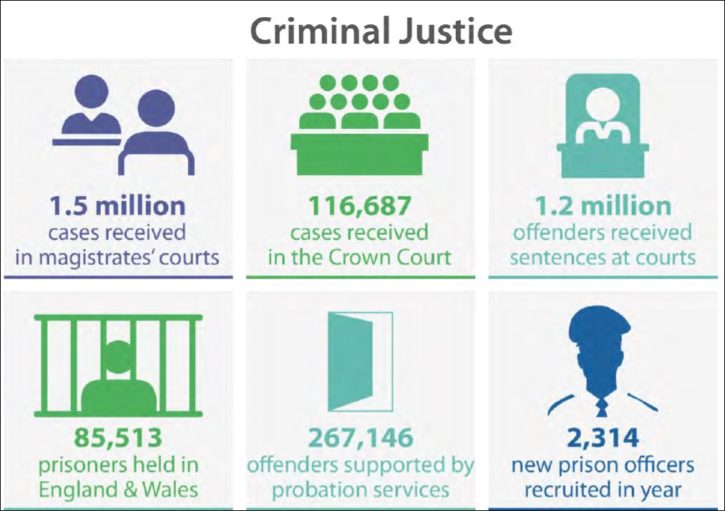
5: The MoJ and its agencies breached personal data legislation on seven occasions
There were other data protection failings but these seven incidents were serious enough to be reported to the Information Commissioner’s Office and related to the personal data of 125 individuals.
6: Seven MoJ staff were paid £150,000 or more
You will see I have taken the BBC benchmark, full table below:
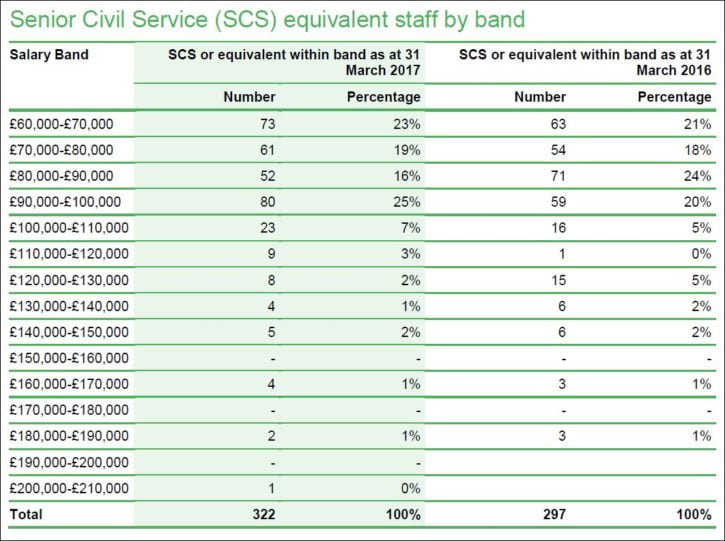
Worst figures ever
The latest safety in Custody statistics bulletin published last Thursday (27 July 2017) confirm the dire picture of prison safety revealed by the Chief Inspector of Prisons in his annual report earlier in the month. The figures cover deaths in prison custody for the year to June 2017 and assaults and self-harm for the year to March 2017.
As you can see from the main points reproduced below, all the key indicators are at extremely worrying levels.
It is clear that staff recruitment is yet to have any impact. Even the small dip in prisoner on prisoner assaults recorded in the previous quarter has been reversed in the latest statistics. Serious assaults on staff have trebled since 2013; increasing by 5% in the latest quarter to reach yet in another dispiriting record high.

Self-harm
Self-harm trends differ considerably by gender, with a rate of 409 incidents per 1,000 in male establishments (with incidents up 24% on the previous year) compared to a rate of 1,835 per 1,000 in female establishments (a reduction of 8% in number of incidents from the previous year). After five years of stability in the rate of self-harm among males, there has been an increase from 3.0 to 3.4 incidents per self-harming male in the most recent period.
In contrast, the self-harm rate among females has fallen from 6.7 to 6.2 incidents per self-harming female.
Self-harm incidents requiring hospital attendance increased from the previous year in male establishments by 14% to 2,616, while female establishments saw a decrease of 1% to 155 incidents. The proportion of self-harm incidents requiring hospital attendance remained relatively stable at 6.9% to March 2017, compared to 7.1% in the previous year. The slight decrease is due to the fact that the total number of self-harm incidents rose at a higher rate than the number of incidents requiring hospital attendance.
While self-harmers in female establishments were roughly twice as prolific as those in male establishments, self-harmers in male establishments had slightly less than four times the proportion of self-harm incidents that require hospitalisation (7.9% in male establishments compared to 2.2% in female establishments).
Serious assaults
Serious assaults are those which fall into one or more of the following categories: a sexual assault, requires detention in outside hospital as an in-patient; requires medical treatment for concussion or internal injuries; or incurs any of the following injuries: a fracture, scald or burn, stabbing, crushing, extensive or multiple bruising, black eye, broken nose, lost or broken tooth, cuts requiring suturing, bites, temporary or permanent blindness.
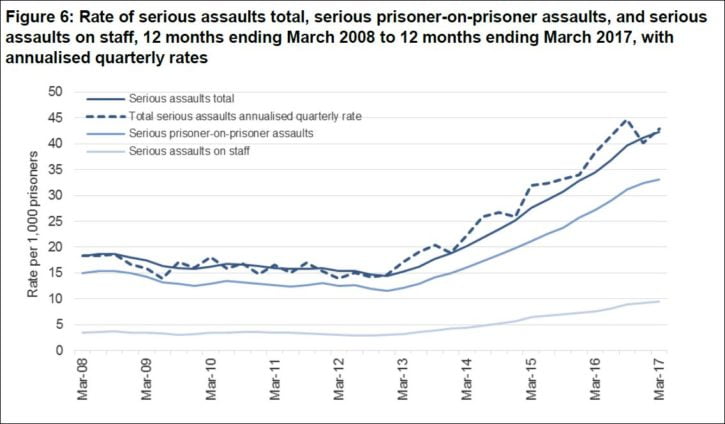
Report card
In the prison annual performance ratings published on the same day, 10 prisons were rated “overall performance is of serious concern”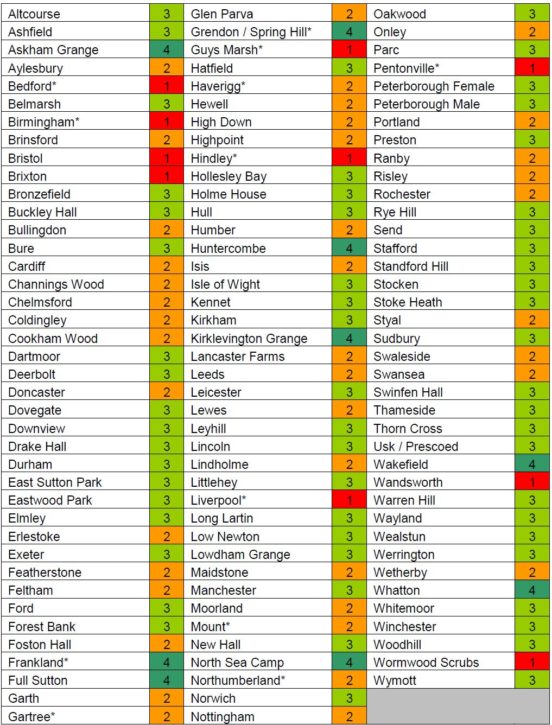
Conclusion
It is hard not to repeat the Chief Inspector’s verdict that without a significant improvement in prison safety, reform seems all but impossible.Trawling the latest MoJ publications
Over the last couple of weeks, I’ve perused the last ever NOMS annual report (the National Offender Management Service was replaced by Her Majesty’s Prisons and Probation Service on 1 April this year) and this year’s Ministry of Justice annual report and accounts for nuggets of information which otherwise might go under the radar.Today it’s the turn of the last ever NOMS digest, published on 27 July 2017, to be exposed to the light of day.
Here are ten facts I found of interest:
1: Failures to return from release on temporary licence
In 2016/17 there were 267 temporary release failures, 42 of which (16%) were failures to return, resulting in prisoners being unlawfully at large. This is an increase of 65% in temporary release failure incidents when compared to 2015/16 and can be partly explained by the increased recording of ‘minor failures’ such as prisoners returning to the prison after the agreed time.Failures to return increased by 75% from 24 incidents in 2015/16, but this is still the second lowest figure in the time series presented.

2: Highest number of prisoners released in error ever
In 2016/17, 71 prisoners were released in error. This is an increase of 7 (11%) from 2015/16, and is the highest in any financial year since the time series began in 2006/07.
3: One quarter of prisoners held in overcrowded conditions
Crowding is measured as the number of prisoners who, at unlock on the last day of the month, are held in a cell, cubicle or room where the number of occupants exceeds the uncrowded capacity of the cell, cubicle or room. This includes the number of prisoners held two to a single cell, three prisoners in a cell designed for one or two and any prisoners held crowded in larger cells or dormitories. 24.5% of prisoners were held in crowded conditions in 2016/17. Unsurprisingly, crowding is worst in male local prisons where the rate is almost 50%.4: Working in prisons
Last year an average of 11,200 prisoners worked 16 million hours in prisons and Immigration Removal Centres; (surprisingly) identical figures to the previous year.
5: Working outside prisons
There were a total of 1,675 active prisoners, on average 368 prisoners per month, working out of the prison on licence. These prisoners had average net earnings of around £937 a month from which on average £256 was raised from the Prisoners Earning Act levy to reduce the average net earnings to £681 per month. The levy raised £1.1 million for Victim Support.
6: Accredited programmes in custody fall
In the last 12 months, there was a 1% fall in the number of completions of accredited programmes in custody – from 7,057 in 2015/16 to 6,960 in 2016/17. This is in contrast with the previous year (2014/15 to 2015/16), where the decrease in programme completions was 7%. The overall fall in completions has not been seen for all programme types. Between 2015/16 and 2016/17, there was a 2% rise in (the now discredited) sexual offending treatment programme completions.
7: Accredited programmes in the community plummet
In the last seven years, there has been a 69% fall in accredited programme completions in the community, from 17,545 in 2009/10 to 5,473 in 2016/17. This was driven by a:- 82% drop in offender behaviour programme completions (offender behaviour programmes in a community setting defined as General offending, Substance Misuse and Violence programmes);
- 25% drop in sexual offending treatment programme completions;
- 38% drop in domestic violence programme completions.
- 28% drop in offender behaviour programme completions;
- 24% drop in domestic violence programme completions;
- 5% drop in sexual offending treatment programme completions.

8: 51 babies were in prison last year
There are currently five Mother and Baby Units in operation across the women’s prison estate in England and Wales which provide an overall total capacity of 52 places for mothers. However, there are a total of 57 places for babies to allow for twins. 61 women and 51 babies were received into a MBU in the 2016/17 financial year. This compares with 64 women and 57 babies in 2015/16 and is a continuation of the fall seen since 2010/11. There were 38 mothers and 40 babies in a MBU at the end of the financial year 2016/17.
9: Fewer offenders are tagged
At 31 March 2017, the total number of subjects actively monitored with an Electronic Monitoring device was 11,493, a fall of 9% compared to the same point in the previous year, continuing a downward trend which is linked to a decrease in the court caseload (court ordered tagging — as a bail condition and sentence — make up 76% of the total tagging caseload). The number of offenders subject to tagging on release from prison has increased.
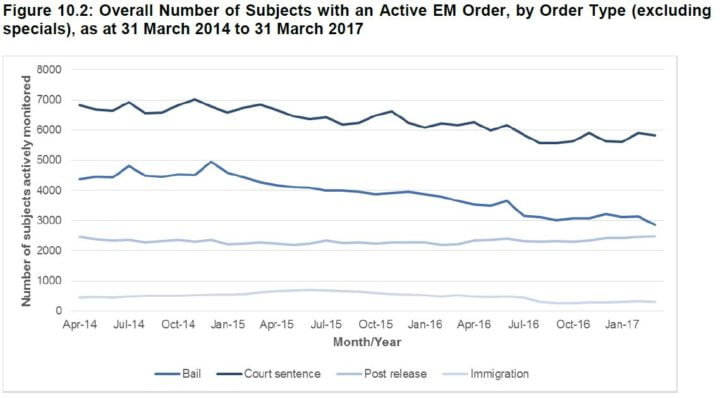
10: More demand for Bail Accommodation and Support
Bail Accommodation and Support Services (BASS) provide accommodation to offenders from courts, offenders from custody and Home Detention Curfew requirement offenders. These offenders are placed in BASS-owned properties when they do not have a permanent place to live. In the financial year 2016/17, there was 1,957 referrals, an increase of 11% on the 1,770 made in 2015/16.http://www.russellwebster.com/moj1617/
http://www.russellwebster.com/10-things-from-the-last-ever-noms-digest/
No comments:
Post a Comment
comment
Note: only a member of this blog may post a comment.